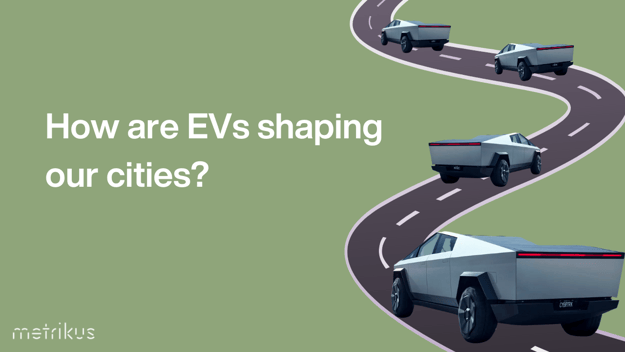Electric vehicles and the future of cities
It comes as no surprise that we’re in the midst of a major climate crisis. With transport contributing around 30% of greenhouse gas emissions worldwide, the shift to electric vehicles (EVs) is gaining popularity in a bid to reduce environmental impact and improve the quality of our air.
The past few years have seen huge developments in this sector (you’ll notice a real truck theme going on here); Tesla’s Cybertruck includes updates to their self-driving hardware, Volkswagon have just announced their new brand ‘Scout’ – dedicated to electric off-road vehicles like their new pick-up truck, and Ford released an electric version of their iconic F-150 model.

Tesla Cybertruck
The move to EVs is well underway: in 2020, 2% of vehicles sold into the US were electric. In 2021 this figure increased to 3% – this may not sound like a huge increase, but it shows definite, consistent growth in the field. And the goals to keep the trajectory growing are lofty: US automobile manufacturers aim to boost this figure to 50%.
India, a country with notoriously poor air quality, also aims to make 30% of all vehicle sales electric by 2030.
Integrating new electric infrastructure into our cities will make the adoption of EVs even easier, and prepping our cities for this shift is a crucial step in energy innovation, greener public and private transport, and cleaner air.
What are the benefits of EVs?
Compared with petrol or diesel powered vehicles, EVs have a load of advantages:
- Quieter engines
- Release lower levels of greenhouse gas emissions
- Open up possibilities for autonomous and connected vehicles
- No congestion charge
- Lower running costs
- Free parking through many government schemes
- Better driving experience
- Higher resale value
What would a city with electric vehicles look like?
A city taken over with EVs is going to look different. There are obvious differences – like quieter roads, much less air pollution, and more availability of charging ports – but structural changes to how we interact with vehicles will occur too. Think smart apps to make travelling much more seamless and convenient, as well as more ways to access energy to power these vehicles.
Obviously electricity isn’t always a clean energy source – much of it is generated through burning fossil fuels. But moving forward this will change; where drivers power their cars with fuel from a gas station, in the future we’ll be able to choose electricity to power EVs based on energy source and opt for cleaner options, like wind or solar.
What are the hesitations with EV adoption?
When it comes to EVs taking over the streets, a lot of resistance comes from assumptions that are simply incorrect, or will be resolved as the technology advances – such as how often they need charging and how long this takes. Eventually, wireless charging will be available, and batteries will mean drivers can go for even longer without having to charge.
It’s also worth noting that as these vehicles become more common, parts will be recycled – making them an even more environmentally friendly choice.
A very real challenge, however, is a lack of availability – customers wanting to buy EVs are being presented with huge waiting times. Volkswagen just announced that they’ve sold out of EVs in the US and Europe until the end of the year, while Ford’s E-Transit went out of stock before manufacturing even began.

Ford E-Transit
For EVs to become the majority on our roads, supply needs to meet the demands set out by targets and bans – the UK plans to ban the sale of new petrol and diesel cars by 2030, and Norway plans to do so by 2025.
At the moment, there simply aren’t enough EVs being made. Supply chains have undeniably been affected by COVID-19, but despite hopeful targets of transitioning to greener modes of transport, people still need vehicles.
So, where do EVs go next?
While EV popularity continues to grow, experts are predicting a rise in autonomous vehicles that will be able to interact with each other to minimize traffic and reduce accidents – sounds pretty good to us.
We could also see the rise of more connected technology, think being able to control certain aspects of our vehicles through apps. A particularly futuristic idea is smart road surfaces: technology underneath the road surface that charges cars as they drive.
We’re personally very excited to see what’s next for the EV industry. One thing’s for certain, to reduce our impact on the environment, our current approach to transport needs an overhaul.




